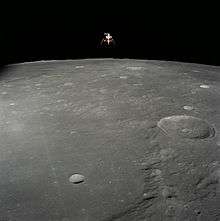Exploration of the Moon
The physical exploration of the Moon began when Luna 2, a space probe launched by the Soviet Union, made an impact on the surface of the Moon on September 14, 1959. Prior to that the only available means of exploration had been observation from Earth. The invention of the optical telescope brought about the first leap in the quality of lunar observations. Galileo Galilei is generally credited as the first person to use a telescope for astronomical purposes; having made his own telescope in 1609, the mountains and craters on the lunar surface were among his first observations using it.
NASA's Apollo program was the only program to successfully land humans on the Moon, which it did six times. The first landing took place in 1969, when two Apollo 11 astronauts placed scientific instruments and returned lunar samples to Earth.
Before spaceflight

The ancient Greek philosopher Anaxagoras (d. 428 BC) reasoned that the Sun and Moon were both giant spherical rocks, and that the latter reflected the light of the former. His non-religious view of the heavens was one cause for his imprisonment and eventual exile.[1] In his book On the Face in the Moon's Orb, Plutarch suggested that the Moon had deep recesses in which the light of the Sun did not reach and that the spots are nothing but the shadows of rivers or deep chasms. He also entertained the possibility that the Moon was inhabited. Aristarchus went a step further and computed the distance from Earth, together with its size, obtaining a value of 20 times the Earth radius for the distance (the real value is 60; the Earth radius was roughly known since Eratosthenes).
Although the Chinese of the Han Dynasty (202 BC–202 AD) believed the Moon to be energy equated to qi, their 'radiating influence' theory recognized that the light of the Moon was merely a reflection of the Sun (mentioned by Anaxagoras above).[2] This was supported by mainstream thinkers such as Jing Fang,[2] who noted the sphericity of the Moon.[2] Shen Kuo (1031–1095) of the Song Dynasty (960–1279) created an allegory equating the waxing and waning of the Moon to a round ball of reflective silver that, when doused with white powder and viewed from the side, would appear to be a crescent.[2]
By 499 AD, the Indian astronomer Aryabhata mentioned in his Aryabhatiya that reflected sunlight is the cause behind the shining of the Moon.[3]
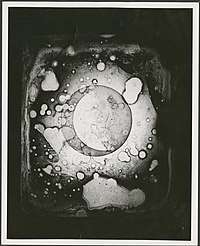
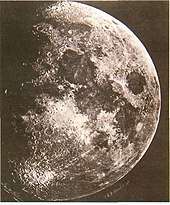
Habash al-Hasib al-Marwazi, a Persian astronomer, conducted various observations at the Al-Shammisiyyah observatory in Baghdad between 825 and 835 AD.[4] Using these observations, he estimated the Moon's diameter as 3,037 km (equivalent to 1,519 km radius) and its distance from the Earth as 346,345 km (215,209 mi), which come close to the currently accepted values.[4] In the 11th century, the Islamic physicist, Alhazen, investigated moonlight, which he proved through experimentation originates from sunlight and correctly concluded that it "emits light from those portions of its surface which the sun's light strikes."[5]
By the Middle Ages, before the invention of the telescope, an increasing number of people began to recognise the Moon as a sphere, though many believed that it was "perfectly smooth".[6] In 1609, Galileo Galilei drew one of the first telescopic drawings of the Moon in his book Sidereus Nuncius and noted that it was not smooth but had mountains and craters. Later in the 17th century, Giovanni Battista Riccioli and Francesco Maria Grimaldi drew a map of the Moon and gave many craters the names they still have today. On maps, the dark parts of the Moon's surface were called maria (singular mare) or seas, and the light parts were called terrae or continents.
Thomas Harriot, as well as Galilei, drew the first telescopic representation of the Moon and observed it for several years. His drawings, however, remained unpublished.[7] The first map of the Moon was made by the Belgian cosmographer and astronomer Michael Florent van Langren in 1645.[7] Two years later a much more influential effort was published by Johannes Hevelius. In 1647 Hevelius published Selenographia, the first treatise entirely devoted to the Moon. Hevelius's nomenclature, although used in Protestant countries until the eighteenth century, was replaced by the system published in 1651 by the Jesuit astronomer Giovanni Battista Riccioli, who gave the large naked-eye spots the names of seas and the telescopic spots (now called craters) the name of philosophers and astronomers.[7] In 1753 the Croatian Jesuit and astronomer Roger Joseph Boscovich discovered the absence of atmosphere on the Moon. In 1824 Franz von Gruithuisen explained the formation of craters as a result of meteorite strikes.[8]
The possibility that the Moon contains vegetation and is inhabited by selenites was seriously considered by major astronomers even into the first decades of the 19th century. In 1834–1836, Wilhelm Beer and Johann Heinrich Mädler published their four-volume Mappa Selenographica and the book Der Mond in 1837, which firmly established the conclusion that the Moon has no bodies of water nor any appreciable atmosphere.
Space race
The Cold War-inspired "space race" and "Moon race" between the Soviet Union and the United States of America accelerated with a focus on the Moon. This included many scientifically important firsts, such as the first photographs of the then-unseen far side of the Moon in 1959 by the Soviet Union, and culminated with the landing of the first humans on the Moon in 1969, widely seen around the world as one of the pivotal events of the 20th century, and indeed of human history in general.
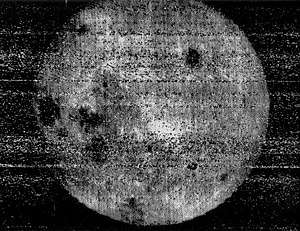
.jpg)
The first artificial object to reach the Moon was the uncrewed Soviet probe Luna 2, which made a hard landing on September 14, 1959, at 21:02:24 UTC. The far side of the Moon was first photographed on October 7, 1959, by the Soviet probe Luna 3. Though vague by today's standards, the photos showed that the far side of the Moon almost completely lacked maria. In an effort to compete with these Soviet successes, U.S. President John F. Kennedy proposed the manned Moon landing in a Special Message to the Congress on Urgent National Needs:
Now it is time to take longer strides - time for a great new American enterprise - time for this nation to take a clearly leading role in space achievement, which in many ways may hold the key to our future on Earth.
...I believe that this nation should commit itself to achieving the goal, before this decade is out, of landing a man on the Moon and returning him safely to the Earth. No single space project in this period will be more impressive to mankind, or more important in the long-range exploration of space; and none will be so difficult or expensive to accomplish.[9] Full text
.png)
In 1966 the USSR accomplished the first soft landings and took the first pictures from the lunar surface during the Luna 9 and Luna 13 missions. The U.S. followed with the Surveyor program (December 1964[10] through January 1968) sending seven robotic spacecraft to the surface of the Moon. Five of the seven spacecraft successfully soft-landed, investigating if the regolith (dust) was shallow enough, for astronauts to stand on the Moon.

On December 24, 1968, the crew of Apollo 8, Frank Borman, James Lovell and William Anders, became the first human beings to enter lunar orbit and see the far side of the Moon in person. Humans first landed on the Moon on July 20, 1969. The first human to walk on the lunar surface was Neil Armstrong, commander of the U.S. mission Apollo 11. The first robot lunar rover to land on the Moon was the Soviet vessel Lunokhod 1 on November 17, 1970, as part of the Lunokhod programme. To date, the last human to stand on the Moon was Eugene Cernan, who as part of the Apollo 17 mission, walked on the Moon in December 1972. See also: A full list of lunar Apollo astronauts.
Moon rock samples were brought back to Earth by three Luna missions (Luna 16, 20, and 24) and the Apollo missions 11 through 17 (except Apollo 13, which aborted its planned lunar landing).
From the mid-1960s to the mid-1970s there were 65 Moon landings (with 10 in 1971 alone), but after Luna 24 in 1976 they suddenly stopped. The Soviet Union started focusing on Venus and space stations and the U.S. on Mars and beyond, and on the Skylab and Space Shuttle program.
Before the Moon race the US had pre-projects for scientific and military moonbases: the Lunex Project and Project Horizon. Besides crewed landings, the abandoned Soviet crewed lunar programs included the building of a multipurpose moonbase "Zvezda", the first detailed project, complete with developed mockups of expedition vehicles[11] and surface modules.[12]
After 1990
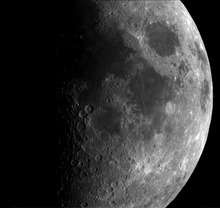
In 1990 Japan visited the Moon with the Hiten spacecraft, becoming the third country to place an object in orbit around the Moon. The spacecraft released the Hagoromo probe into lunar orbit, but the transmitter failed, thereby preventing further scientific use of the spacecraft. In September 2007, Japan launched the SELENE spacecraft, with the objectives "to obtain scientific data of the lunar origin and evolution and to develop the technology for the future lunar exploration", according to the JAXA official website.[13]
The European Space Agency launched a small, low-cost lunar orbital probe called SMART 1 on September 27, 2003. SMART 1's primary goal was to take three-dimensional X-ray and infrared imagery of the lunar surface. SMART 1 entered lunar orbit on November 15, 2004 and continued to make observations until September 3, 2006, when it was intentionally crashed into the lunar surface in order to study the impact plume.[14]
China has begun the Chinese Lunar Exploration Program for exploring the Moon and is investigating the prospect of lunar mining, specifically looking for the isotope helium-3 for use as an energy source on Earth.[15] China launched the Chang'e 1 robotic lunar orbiter on October 24, 2007. Originally planned for a one-year mission, the Chang'e 1 mission was very successful and ended up being extended for another four months. On March 1, 2009, Chang'e 1 was intentionally impacted on the lunar surface completing the 16-month mission. On October 1, 2010, China launched the Chang'e 2 lunar orbiter. China landed the rover Chang'e 3 on the Moon on December 14, 2013, became the third country to have done so.[16] Chang'e 3 is the first spacecraft to soft-land on lunar surface since Luna 24 in 1976. Since the Chang'e 3 mission was a success, the backup lander Chang'e 4 was re-purposed for the new mission goals. China launched on 7 December 2018 the Chang'e 4 mission to the lunar farside.[17] On 3 January 2019, Chang'e 4 landed on the far side of the Moon.[18] The dust at some locations of the far side of the Moon has proven to be up to 12 meters deep.[19]
India's national space agency, Indian Space Research Organisation (ISRO), launched Chandrayaan-1, an uncrewed lunar orbiter, on October 22, 2008.[20] The lunar probe was originally intended to orbit the Moon for two years, with scientific objectives to prepare a three-dimensional atlas of the near and far side of the Moon and to conduct a chemical and mineralogical mapping of the lunar surface.[21][22] The orbiter released the Moon Impact Probe which impacted the Moon at 15:04 GMT on November 14, 2008 [23] making India the fourth country to reach the lunar surface. Among Chandrayaan's many achievements was the discovery of the widespread presence of water molecules in the lunar soil.[24] This mission was followed up by Chandrayaan-2 which launched on 22 July 2019 and entered lunar orbit on 20 August 2019. Chandrayaan-2 also carried India's first lander and rover, but these crash-landed.[25]

Lunar Reconnaissance Orbiter · Moon
The Ballistic Missile Defense Organization and NASA launched the Clementine mission in 1994, and Lunar Prospector in 1998. NASA launched the Lunar Reconnaissance Orbiter, on June 18, 2009, which has collected imagery of the Moon's surface. It also carried the Lunar Crater Observation and Sensing Satellite (LCROSS), which investigated the possible existence of water in Cabeus crater. GRAIL is another mission, launched in 2011.
The first commercial mission to the Moon was accomplished by the Manfred Memorial Moon Mission (4M), led by LuxSpace, an affiliate of German OHB AG. The mission was launched on 23 October 2014 with the Chinese Chang'e 5-T1 test spacecraft, attached to the upper stage of a Long March 3C/G2 rocket.[26][27] The 4M spacecraft made a Moon flyby on a night of 28 October 2014, after which it entered elliptical Earth orbit, exceeding its designed lifetime by four times.[28][29]
The Beresheet lander operated by Israel Aerospace Industries and SpaceIL impacted the Moon on 11 April 2019 after a failed landing attempt.[30]
Plans
Following the abandoned US Constellation program, plans for crewed flights followed by moonbases were declared by Russia, Europe (ESA), China, Japan and India. All of them intend to continue the exploration of Moon with more uncrewed spacecraft.
China planned to conduct a sample return mission with its Chang'e 5 spacecraft in 2017, but that mission has been postponed[31] due to the failure of the Long March 5 launch vehicle.[32]. However, after a successful return of flight by its Long March 5 in late Dec, 2019, China is targeting its Chang'e 5 sample return mission in late 2020[33]
India may launch another lunar mission in 2021: the Chandrayaan-3, and it is studying a potential collaboration with Japan to launch the Lunar Polar Exploration Mission in 2024.
Russia also announced plans to resume its previously frozen project Luna-Glob, an uncrewed lander and orbiter, which is slated to launch in 2021.[34] In 2015, Roscosmos stated that Russia plans to place an astronaut on the Moon by 2030 leaving Mars to NASA. The purpose is to work jointly with NASA and avoid a space race[35] Russian Orel spacecraft is planned to send cosmonauts into Moon orbit in 2025.[36] Russian Lunar Orbital Station is then proposed to orbit around the Moon after 2030.
In 2018 NASA released plans to "return to the Moon with commercial and international partners as part of an overall agency Exploration Campaign in support of Space Policy Directive 1, giving rise to the Artemis program and the Commercial Lunar Payload Services (CLPS). NASA plans to start with robotic missions on the lunar surface, as well as the crewed Lunar Gateway. As of 2019, NASA is issuing contracts to develop new small lunar payload delivery services, develop lunar landers, and conduct more research on the Moon's surface ahead of a human return.[37] Artemis program involves several flights of the Orion spacecraft and lunar landings from 2022 to 2028.[38][39]
See also
References
- O'Connor, J.J.; Robertson, E.F. (February 1999). "Anaxagoras of Clazomenae". University of St Andrews. Retrieved 2007-04-12.
- Needham, Joseph (1986). Mathematics and the Sciences of the Heavens and Earth. Science and Civilization in China. 3. Taipei: Caves Books. p. 227; 411–416. ISBN 978-0-521-05801-8.
- Hayashi (2008), Aryabhata I
- Langermann, Y. Tzvi (1985). "The Book of Bodies and Distances of Habash al-Hasib". Centaurus. 28 (2): 111–112. Bibcode:1985Cent...28..108T. doi:10.1111/j.1600-0498.1985.tb00831.x.
- Toomer, G. J. (December 1964). "Review: Ibn al-Haythams Weg zur Physik by Matthias Schramm". Isis. 55 (4): 463–465. doi:10.1086/349914.
- Van Helden, A. (1995). "The Moon". Galileo Project. Archived from the original on 2004-06-23. Retrieved 2007-04-12.
- "The Galileo Project". Archived from the original on September 5, 2007. Retrieved 2007-09-14.
- Энциклопедия для детей (астрономия). Москва: Аванта+. 1998. ISBN 978-5-89501-016-7.
- Kennedy, John F. (May 25, 1961). Special Message to Congress on Urgent National Needs (Motion picture (excerpt)). Boston, MA: John F. Kennedy Presidential Library and Museum. Accession Number: TNC:200; Digital Identifier: TNC-200-2. Retrieved August 1, 2013.
- https://nssdc.gsfc.nasa.gov/nmc/spacecraft/display.action?id=1964-082A – 24 January 2020
- "LEK Lunar Expeditionary Complex". astronautix.com. Archived from the original on 8 December 2013. Retrieved 12 June 2015.
- "DLB Module". astronautix.com. Archived from the original on 7 January 2014. Retrieved 12 June 2015.
- "Kaguya (SELENE)". JAXA. Retrieved 2007-06-25.
- "SMART-1 Impacts Moon". ESA. 4 September 2006. Archived from the original on 2006-10-25. Retrieved 2006-09-03.
- David, Leonard (4 March 2003). "China Outlines its Lunar Ambitions". Space.com. Archived from the original on March 16, 2006. Retrieved 2006-03-20.
- "Technological advancements and promotion roles of Chang'e-3 lunar probe mission". Sci China Tech Sci. 56 (11): 2702. 2013.
- China launches historic mission to land on far side of the Moon Stephen Clark, Spaceflight Now. 07 December 2018.
- Devlin, Hannah; Lyons, Kate (2019-01-03). "Far side of the moon: China's Chang'e 4 probe makes historic touchdown". The Guardian. ISSN 0261-3077. Retrieved 2019-06-06.
- Morgan McFall (26 Feb 2020) China's lunar rover finds nearly 40 feet of dust on the far side of the moon
- "Archived copy". Archived from the original on 2008-12-12. Retrieved 2009-05-22.CS1 maint: archived copy as title (link)
- "Chandrayaan-1 Scientific Objectives". Indian Space Research Organisation. Archived from the original on 2009-10-12.
- http://www.deccanherald.com/CONTENT/Sep192008/national2008091890838.asp%5B%5D
- "India sends probe on to the Moon". BBC. November 14, 2008. Retrieved 2008-11-16.
- Lunar Missions Detect Water on Moon Archived 2009-10-03 at the Wayback Machine
- "Chandrayaan - 2 Latest Update - ISRO". www.isro.gov.in. Retrieved 2019-10-07.
- "First commercial mission to the Moon launched from China". Spaceflight Now. 25 October 2014. Retrieved 24 July 2015.
- "China Readies Moon Mission for Launch Next Week". Space.com. 14 October 2014. Retrieved 24 July 2015.
- "Saft lithium batteries powered the 4M mini-probe to success on the world's first privately funded Moon mission" (Press release). paris: Saft. 21 January 2015. Archived from the original on 24 July 2015. Retrieved 24 July 2015.
- "Flyby has occurred this night". LuxSpace. 28 October 2015. Retrieved 24 July 2015.
- Lidman, Melanie. "Israel's Beresheet spacecraft crashes into the moon during landing attempt". www.timesofisrael.com. Retrieved 2019-10-07.
- Nowakowski, Tomasz (9 August 2017). "China Eyes Manned Lunar Landing by 2036". Retrieved 17 August 2017.
- Jeff Foust (25 September 2017). "Long March 5 failure to postpone China's lunar exploration program". SpaceNews. Retrieved 17 December 2017.
- Jones, Andrew (1 November 2019). "China targets late 2020 for lunar sample return mission". SpaceNews. Retrieved 26 January 2020.
- Covault, Craig (2006-06-04). "Russia Plans Ambitious Robotic Lunar Mission".
- "Russia to place man on Moon by 2030 leaving Mars to NASA". 2015-06-27.
- "Russia may select first crew for its Federation spacecraft next year". Spaceflightinsider.com.
- Warner, Cheryl (2018-04-30). "NASA Expands Plans for Moon Exploration". NASA. Retrieved 2019-04-01.
- "National Space Exploration Campaign Report" (PDF). NASA. September 2018.
- "Moon to Mars | NASA". Retrieved 2019-06-10.
External links
| Wikimedia Commons has media related to Moon exploration. |
